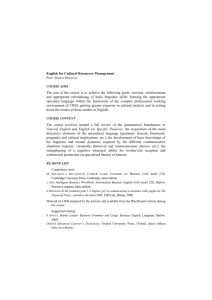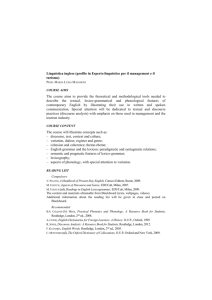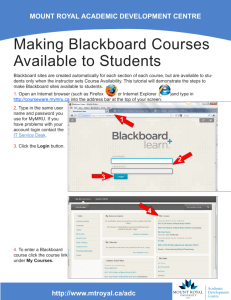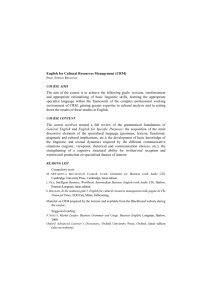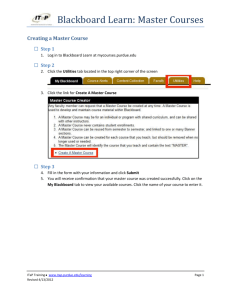Phil 2621: Minds and Machines
advertisement
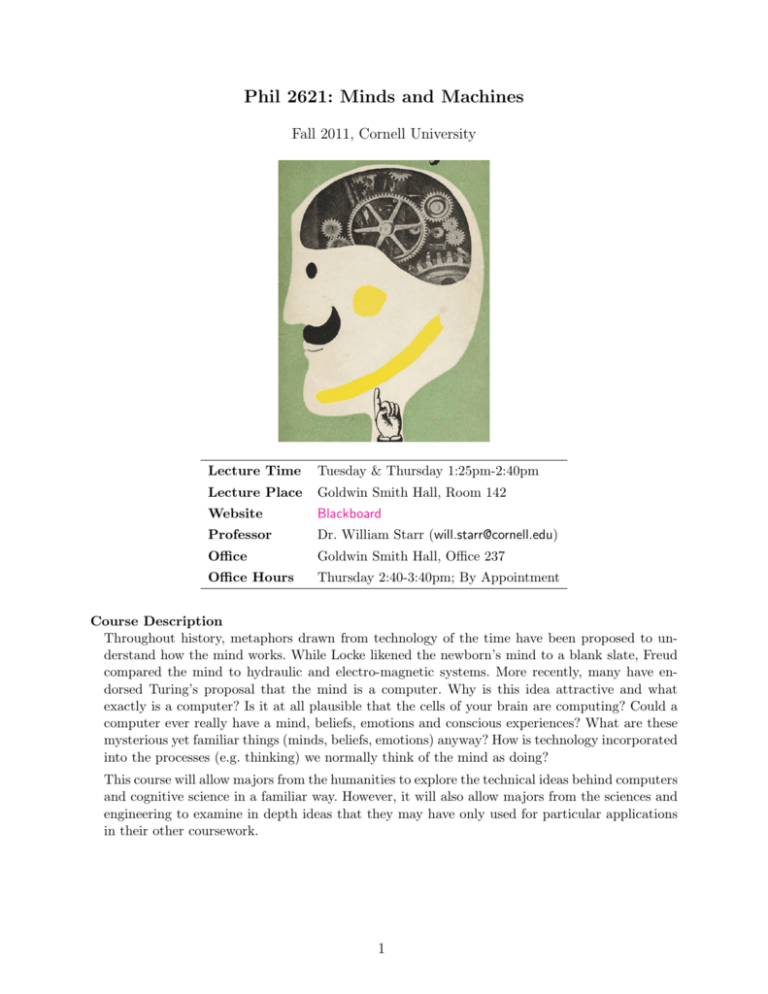
Phil 2621: Minds and Machines Fall 2011, Cornell University Lecture Time Tuesday & Thursday 1:25pm-2:40pm Lecture Place Goldwin Smith Hall, Room 142 Website Blackboard Professor Dr. William Starr (will.starr@cornell.edu) Office Goldwin Smith Hall, Office 237 Office Hours Thursday 2:40-3:40pm; By Appointment Course Description Throughout history, metaphors drawn from technology of the time have been proposed to understand how the mind works. While Locke likened the newborn’s mind to a blank slate, Freud compared the mind to hydraulic and electro-magnetic systems. More recently, many have endorsed Turing’s proposal that the mind is a computer. Why is this idea attractive and what exactly is a computer? Is it at all plausible that the cells of your brain are computing? Could a computer ever really have a mind, beliefs, emotions and conscious experiences? What are these mysterious yet familiar things (minds, beliefs, emotions) anyway? How is technology incorporated into the processes (e.g. thinking) we normally think of the mind as doing? This course will allow majors from the humanities to explore the technical ideas behind computers and cognitive science in a familiar way. However, it will also allow majors from the sciences and engineering to examine in depth ideas that they may have only used for particular applications in their other coursework. 1 Readings There are two required textbooks for this course: • Andy Clark’s Mindware (Oxford University Press, 2001) • W. Daniel Hillis’ The Pattern on the Stone (Basic Books, 1998) Both are available at the Cornell Bookstore and through Amazon. All other readings will be made available through Blackboard. Advice: It is more important to have a basic grasp of the overall point of a reading than to understand any particular detail. Accordingly, I advise you to do each of the readings once quickly in a single sitting and then return to the details you missed. If, on a second reading, you can’t sort out some specific detail, write down what you don’t understand and bring it to class for discussion. Do your best to raise your question at a point in the class where that detail is relevant to what’s being discussed. It is much more likely that you will get a satisfying answer if you ask your question at the appropriate time. In all the readings, it will be helpful to ask yourself ‘what is the problem or issue at stake here?’ and then ‘what solutions or positions is the author arguing for here?’ Grading • 25%: Essay 1, 1500 Word Limit (≈ 5 pages) Due 10.06 at the beginning of lecture. Topics will be provided on Blackboard. In addition to turning in this paper copy, you must submit an electronic copy to Blackboard by 11:55pm on 10.06. Blackboard will submit this electronic copy to Turnitin.com, a plagiarism detection service. Your paper does not count as turned in until you turn in both a paper and an electronic copy. • 25%: Essay 2, 1700 Word Limit (≈ 5 pages) Due 12.15. Topics will be provided on Blackboard. You must submit an electronic copy to Blackboard by 11:55pm on 12.15. Blackboard will submit this electronic copy to Turnitin.com, a plagiarism detection service. • 30%: Pop Quizzes Throughout the semester there will be 10 short pop quizzes given in lecture. These will be very basic comprehension quizzes with short answer questions. Sometimes they will be given at the beginning of lecture, in which case they will cover the readings for that meeting. Sometimes they will be towards the end of class, in which case they will cover the contents of that meeting. It is therefore essential to your success in this class that you do the readings, attend lecture and ask questions when you do not understand the material. Except in cases of documented and valid emergencies, you will not be able to make up missed quizzes. If you have a problem making class regularly, drop this course. • 20%: Journal Entries Throughout the semester you will be required to write 4 journal entries on Blackboard. These will be brief (400 word max) explorations of important ideas, personal interests and readings. Website There is a Blackboard site for this course. You can access it by going to blackboard.cornell.edu, logging in and clicking on the ‘My Blackboard’ tab. Your Blackboard courses will appear in a box on the right side of the page. Select “Phil 2621-Starr-Fall2011: Minds and Machines”. It will be tremendously helpful for you to check site regularly. I will post some readings, this syllabus, lecture slides and announcements on the website. The discussion board can be used to post questions about the readings, assignments or lectures. 2 Schedule Readings marked with ‘*’ are optional. Readings may change as the semester goes on. Updated versions of this syllabus will be posted on Blackboard as changes are made. Date Notes Reading Topics Week 1 Introduction 08.25 Class Cancelled Class Cancelled Week 2 What’s a Mind? 08.30 [5: 7-21], [11]* Dualism (Soul Theory) 09.01 [5: 26-34], [28]* Mind = Brain? (Identity Theory) Week 3 What’s a Mind? / Computation? 09.06 [5: 23-5, 36-42], [26]* Behaviorism, Functionalism 09.08 [17: Ch.1] Nuts & Bolts Week 4 What is Computation? 09.13 [17: Ch.2] Building Blocks 09.15 [17: Ch.3-4] Programming, Limits Week 5 Computational Minds 09.20 [6: Ch.1], [15: Ch.2]*, [14: 3-11, 13-30]* Computational Minds 09.22 [10], [30]* Computation & Language Week 6 The Mind as a Computer 09.27 09.29 In-Class Video [6: Ch.2], [22]* Symbol Systems [27], [24]* Robosemantics Week 7 Intentionality 10.04 10.06 Essay 1 Due [12: Ch.3], [17: Ch.6]* Information, Representation [13], [20], [15: Ch.4]* Intentionality Week 8 The Brain & Levels 10.11 [14: Ch.3], [5: 156-65]* How could the brain compute? 10.13 [19: 8-38], [14: Ch.4]* Levels, Vision, Owl Sonar Week 9 Connectionism 10.18 [16: Ch.6], [6: Ch.4]* Connectionism 10.20 [16: Ch.7] Symbolic v. Connectionist AI Week 10 Patterns & Simple Systems 10.25 [6: Ch.3], [9]* Patterns and Causes 10.27 [6: Ch.5] Simple AI 3 Date Notes Reading Topics Week 11 Artificial Life, Cyborgs 11.01 [6: Ch.6], [16: Ch.9]* Artificial Life 11.03 [6: Ch.8], [23], [18]* We are (and should be) Cyborgs Week 12 Consciousness 11.08 [4: 3-25], [21]* Consciousness I 11.10 [4: 25-37], [3: Ch.9]* Consciousness II Week 13 Emotion 11.15 [7: 35-56] What’s emotion? 11.17 [7: 56-81], [1]* What’s emotion? Is it mechanical? Week 14 Emotion and Machines 11.22 11.24 No Class [2], [25: Ch.1]* Affective Robotics & Computing No Class Thanksgiving Week 15 Free Will & Self 11.29 [8] Self 12.01 [29] Free Will 12.06 No Class No Class Study Period 12.08 No Class No Class Exams 12.13 No Class No Class Exams 12.15 Essay 2 Due No Class Essay 2 Due References [1] [2] [3] [4] [5] [6] [7] [8] [9] Adolphs, R (2005). ‘Could a Robot Have Emotions?’ In JM Fellous & MA Arbib (eds.), Who Needs Emotions?: The Brain Meets the Robot, Series in Affective Science, 9–25. New York: Oxford University Press. Breazeal, C & Brooks, R (2005). ‘Robot Emotion: a functional perspective.’ In JM Fellous & MA Arbib (eds.), Who Needs Emotions?: The Brain Meets the Robot, Series in Affective Science, 271–210. New York: Oxford University Press. Chalmers, DJ (1996). The Conscious Mind: In Search of a Fundamental Theory. Oxford: Oxford University Press. Chalmers, DJ (2010). The Character of Consciousness. New York: Oxford University Press. Churchland, PM (1984). Matter and Consciousness. Cambridge, MA: MIT Press. Clark, A (2001). Mindware: An Introduction to the Philosophy of Cognitive Science. New York, NY: New York: Oxford University Press. Damasio, A (1999). The Feeling of What Happens: Body and Emotion in the Making of Consciousness. New York: Harcourt, Inc. Dennett, DC (1978). ‘Where Am I?’ In Brainstorms, 310–323. Montgomery, Vermont: Bradford Books. Dennett, DC (1991). ‘Real Patterns.’ Journal of Philosophy, 88(1): 27–51. 4 [10] Dennett, DC (1998). ‘Can Machines Think?’ In Brainchildren: Essays on Developing Minds, 3–20. Cambridge, Massachusetts: The MIT Press. [11] Descartes, R (2002). ‘The Passions of the Soul.’ In DJ Chalmers (ed.), Philosophy of Mind: Contemporary and Classical Readings, chap. 2, 21–3. New York: Oxford University Press. [12] Dretske, F (1988). Explaining Behavior: Reasons in a World of Causes. Cambridge, Massachusetts: The MIT Press. [13] Dretske, F (2002). ‘A Recipe for Thought.’ In DJ Chalmers (ed.), Philosophy of Mind: Contemporary and Classical Readings, chap. 46, 491–9. New York: Oxford University Press. [14] Edelman, S (2008). Computing the Mind. New York: Oxford University Press. [15] Fodor, JA (1987). Psychosemantics: The Problem of Meaning in the Philosophy of Mind. Cambridge, Massachusetts: The MIT Press. [16] Franklin, S (1995). Artificial Minds. Cambridge, Massachusetts: The MIT Press. [17] Hillis, WD (1998). The Pattern on the Stone: The Simple Ideas that Make Computers Work. New York: Basic Books. [18] Maharbiz, MM & Sato, H (2010). ‘Cyborg Beetles.’ Scientific American, 17: 94–99. [19] Marr, D (1982). Vision: A Computational Investigation into the Human Representation and Processing of Visual Information. San Francisco: W.H. Freeman. [20] Millikan, RG (2002). ‘Biosemantics.’ In DJ Chalmers (ed.), Philosophy of Mind: Contemporary and Classical Readings, chap. 47, 500–8. New York: Oxford University Press. [21] Nagel, T (1974). ‘What Is it Like to Be a Bat?’ The Philosophical Review, 83: 435–450. [22] Newell, A & Simon, HA (1976). ‘Computer Science as Empirical Enquiry: Symbols and Search.’ Communications of the Association for Computing Machinery, 19: 113–126. [23] Nicolelis, MAL (2011). ‘Mind Out of Body.’ Scientific American, 304: 80–83. [24] Parisien, C & Thagard, P (2008). ‘Robosemantics: How Stanley the Volkswagen Represents the World.’ Minds & Machines, 18(2): 169–178. [25] Picard, RA (1997). Affective Computing. Cambridge, Massachusetts: The MIT Press. [26] Putnam, H (1967). ‘The Nature of Mental States.’ In WH Capitan & DD Merrill (eds.), Art, Mind, and Religion, 37–48. Pittsburgh: Pittsburgh University Press. [27] Searle, JR (1980). ‘Minds, Brains, and Programs.’ The Behavioral and Brain Sciences, 3: 417–424. [28] Smart, JJC (2002). ‘Sensations and Brain Processes.’ In DJ Chalmers (ed.), Philosophy of Mind: Contemporary and Classical Readings, chap. 9, 60–8. New York: Oxford University Press. [29] Smullyan, R (2001). ‘Is God a Taoist?’ In D Dennett & D Hofstadter (eds.), The Mind’s I: fantasies and reflections of Self and Soul, 321–344. New York: Basic Book. [30] Turing, AM (1950). ‘Computing Machinery and Intelligence.’ Mind, 59(236): 433–460. 5
